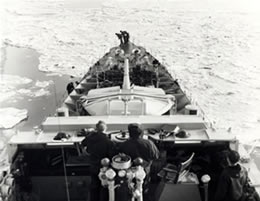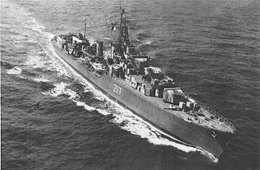Korean War
The end of the Second World War would not be the end of the Canadian Navy’s service far from home in the cause of peace and freedom. The Korean War erupted on June 25, 1950 when North Korea invaded South Korea. The first Canadian military response was made by the RCN less than two weeks after the outbreak of hostilities when three destroyers, HMCS Cayuga, Athabaskan and Sioux set sail for the Far East. They arrived in the theatre of operations later that summer, ready to take part in the battle for the Pusan bridgehead in Korea. Five other tribal class destroyers, HMCS Crusader, Huron, Iroquois, Nootka, and Haida, served with the “Canadian Destroyer Division, Far East” as part of the United Nations (UN) fleet halfway around the world in the waters off Korea during the war.
Korea is a peninsula surrounded on three sides by water, so the navy had an opportunity to support the UN forces in several different ways. The Canadian destroyers did things like blockading the enemy coast, preventing amphibious landings by the enemy, protecting aircraft carriers from the threat of submarine and aerial attack, bombarding enemy-held coastal areas and bringing assistance to those in need in isolated South Korean fishing villages.
Our ocean-going destroyers even made a run up a Korean river in December 1950 when the port city of Chinnampo was facing a massive enemy advance and the order was given to evacuate. UN ships, including three Canadian destroyers, were sent to help. It would not be easy — Chinnampo was more than 30 kilometres up the Taedong River, a waterway heavily mined by the North Koreans.
Two UN ships ran aground and were forced to turn back but the remaining ships, led by HMCS Cayuga, reached the city after a nerve-wracking passage through shallow, twisting channels on a pitch-dark night. The destroyers guarded against possible enemy attack and helped destroy the railway lines, docks and supplies left behind so they could not be used by the enemy. Their job done, the ships returned safely to the ocean.
More than 3,600 Canadians served in the waters off Korea before the armistice was signed on July 27, 1953. UN naval forces continued to serve, however, evacuating islands that were to be returned to North Korea and carrying out routine patrols. It was not until September 1955 that the last Canadian destroyer left the region.
Did You Know?
Among the many duties undertaken by the RCN during the Korean War was the bombarding of rail lines along the enemy coast. The Canadian destroyers that served off the east coast of Korea were part of the "Trainbusters Club." The terrain in that part of the country often forced railroad tracks to hug the coast, which made trains tempting targets. Canadian naval guns stopped many enemy trains from delivering their cargo.
It was a difficult job and danger was always close by. On October 2, 1952, HMCS Iroquois was exchanging fire with an enemy gun battery on shore when the ship took a direct hit. Three Canadian sailors died and 10 were wounded in the explosion.
Related Links
- Date modified:

